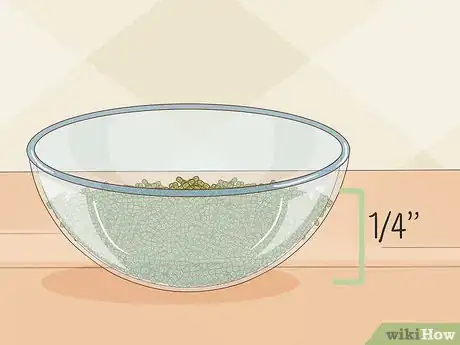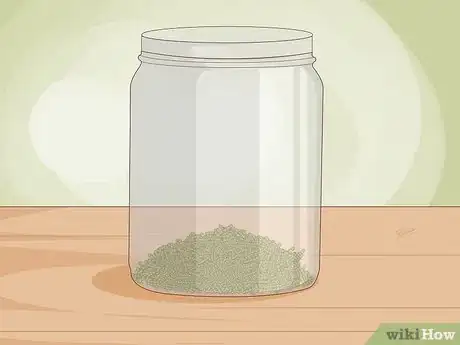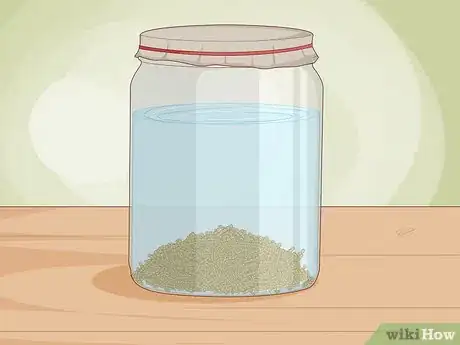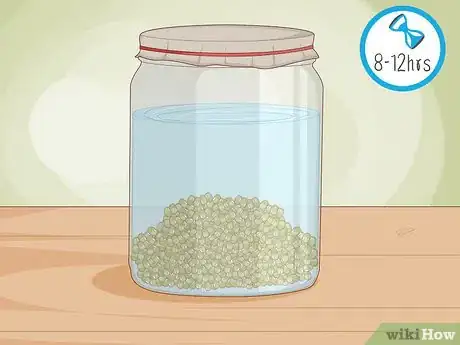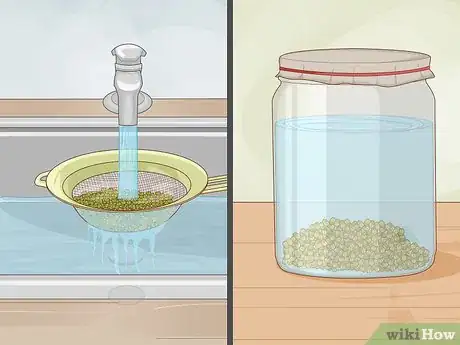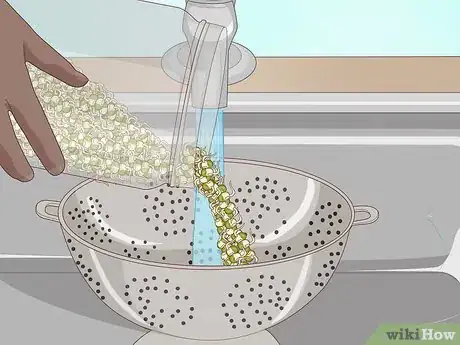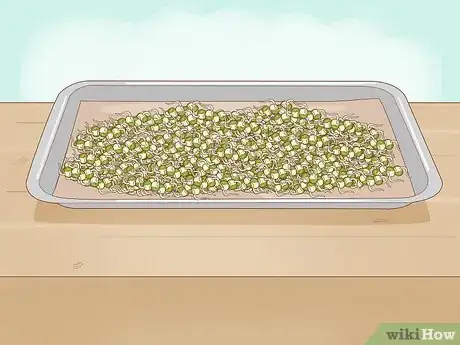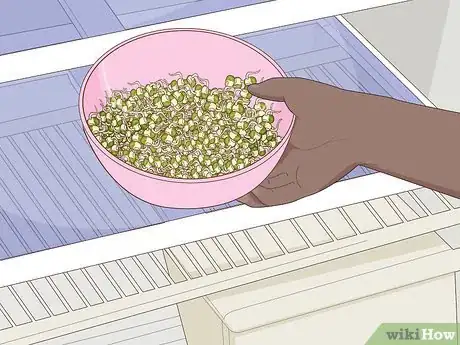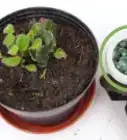This article was co-authored by wikiHow Staff. Our trained team of editors and researchers validate articles for accuracy and comprehensiveness. wikiHow's Content Management Team carefully monitors the work from our editorial staff to ensure that each article is backed by trusted research and meets our high quality standards.
There are 8 references cited in this article, which can be found at the bottom of the page.
wikiHow marks an article as reader-approved once it receives enough positive feedback. This article received 27 testimonials and 89% of readers who voted found it helpful, earning it our reader-approved status.
This article has been viewed 591,416 times.
Learn more...
Mung bean sprouts are a common ingredient in Asian stir frys and provide a crisp, healthy addition to any meal. In the supermarket, you'll often find them labeled more generally as “bean sprouts.” There’s no need to buy them pre-sprouted and you can save money by sprouting them at home in as little as 2 days. Soak your mung beans overnight, then rinse and drain the growing sprouts every 12 hours until the sprouts have reached your desired length.
Steps
Preparing and Soaking the Beans
-
1Purchase whole, untreated mung beans. Do not use beans packaged in gardening packets, which have probably been chemically treated. Check the label to make sure you’re purchasing whole and untreated beans which are made for sprouting and eating.[1]
- Find mung beans at health food stores or online catalogues like Sproutpeople (sproutpeople.org) and Sproutman (sproutman.com).
-
2Measure out your desired amount of mung beans. Consider the size of the bowl or jar you plan to soak them in—the beans should fill about ¼ of the container. Mung beans get much bigger once they sprout, so be careful not to use too much.[2]
- The yield for sprouting mung beans is about 2 to 1, meaning if you use 1 pound of seeds you’ll end up with 2 pounds of sprouts.[3]
Advertisement -
3Rinse your mung beans using a colander or strainer. Run clean water over the beans until it runs clear. They may be dusty, since the majority of mung beans are grown in China and are often left to dry on gravel roads.[4]
- This will help protect you from anything which might have been in the soil, like metals and toxins.
- It will also wash away things like mites that may have made their way into the dried beans.
-
4Place the beans in a clear, wide-mouth jar. Mason canning jars are a great option, but you can also reuse jars that held peanut butter or pasta sauce, for instance. The beans should fill up about a quarter of your container.[5]
-
5Submerge the beans in water and cover the jar with a mesh lid. Fill the jar partway with cool water, roughly 2-3 times the volume of the beans. Then, cover your jar with some type of breathable lid.[6]
- For a homemade option, you can use a piece of cheesecloth secured with rubber band. You could also punch holes into an existing metal or glass lid.
- You could also purchase a specialized sprouting jar, which is sold with a pre-made strainer lid.
- If you don’t have cheesecloth or a mesh lid, you can also soak your beans uncovered in a bowl or jar.
-
6Soak the beans for 8-12 hours until they swell up. How long they have to soak will depend on the beans. Generally, larger beans will require a longer soak. You can place the jar on the countertop or in a cabinet—just make sure it’s not positioned in direct sunlight.[7]
- The beans should be soaking at room temperature, not in the fridge.
Draining and Rinsing the Beans
-
1Drain and rinse the beans through the mesh lid. Drain away the excess water through the lid of your jar by flipping it over in the sink. Then, rinse the swollen beans with fresh water and drain it again.[8]
- If you don’t have a mesh lid or cheesecloth, you can also hold a strainer against the opening of your jar to drain the water.
-
2Put the jar in a cool, dark place for 12 hours. Find a place that gets little to no sunlight where the beans will not be disturbed. Place the jar upside down and at an angle on a dish rack or cooling rack so the moisture can continue to be released.[9]
- Although the beans should not be exposed to direct sunlight, there’s no need for the storage location to be completely dark. A shadowy corner of your countertop would work well.
-
3Repeat this process every 12 hours for 2-5 days. Rinse and drain the beans through the mesh lid approximately every 12 hours (or twice a day). Return them to their dark storage spot after each rinse session.[10]
- The beans should continue to grow in size and sprout thin white tails.
-
4Give the sprouts a rinse once they’ve reached your desired length. Pour the sprouted beans into a colander and give them one last rinse before draining them thoroughly. Generally, mung beans taste good when they’re about 1⁄2 in (1.3 cm) long—but it’s mostly a matter of personal preference.[11]
- The green shells may have started to come off the white bean sprouts at this point. You can remove some of these empty shells from the mix with your hands if you like.[12]
-
5Spread the sprouted beans across a baking sheet lined in paper towels. Cover a baking sheet with two layers of dry paper towels, then pour the rinsed and drained beans on top. Spread them out in a thin layer with your hand and press gently to absorb any excess water. Once you’ve patted them dry, they are ready to be stored.[13]
- Pick out any unsprouted beans and throw them away.
- To dry the beans even more thoroughly, cover them with another paper towel and press gently.
-
6Place the sprouts into a bowl and store in the fridge for up to 2 weeks. Line the bowl with paper towels, then use your hands to transfer handfuls of sprouts into the container. Plan to eat the sprouts within 2 weeks.[14]
- Mung bean sprouts are a great base for a chilled salad, or a classic addition to a stir-fry.
Community Q&A
-
QuestionHow long does it take for a mung bean to sprout?
 wikiHow Staff EditorThis answer was written by one of our trained team of researchers who validated it for accuracy and comprehensiveness.
wikiHow Staff EditorThis answer was written by one of our trained team of researchers who validated it for accuracy and comprehensiveness.
Staff Answer wikiHow Staff EditorStaff AnswerMung beans are among one of the fastest sprouting beans. They will usually begin to sprout within 24 to 36 hours after an initial 12-hour soaking time. However, it’ll be several more days before the sprouts are large enough to be the right size for eating, unless you like very small sprouts.
wikiHow Staff EditorStaff AnswerMung beans are among one of the fastest sprouting beans. They will usually begin to sprout within 24 to 36 hours after an initial 12-hour soaking time. However, it’ll be several more days before the sprouts are large enough to be the right size for eating, unless you like very small sprouts. -
QuestionHow should I store sprouts?
 wikiHow Staff EditorThis answer was written by one of our trained team of researchers who validated it for accuracy and comprehensiveness.
wikiHow Staff EditorThis answer was written by one of our trained team of researchers who validated it for accuracy and comprehensiveness.
Staff Answer wikiHow Staff EditorStaff AnswerLine a glass container with paper towels. Rinse the sprouts, then transfer them to the lined container in handfuls. Place the bowl in the refrigerator and consume within a week.
wikiHow Staff EditorStaff AnswerLine a glass container with paper towels. Rinse the sprouts, then transfer them to the lined container in handfuls. Place the bowl in the refrigerator and consume within a week. -
QuestionAre mung beans and bean sprouts the same thing?
 wikiHow Staff EditorThis answer was written by one of our trained team of researchers who validated it for accuracy and comprehensiveness.
wikiHow Staff EditorThis answer was written by one of our trained team of researchers who validated it for accuracy and comprehensiveness.
Staff Answer wikiHow Staff EditorStaff AnswerMung beans are one type of bean sprouts, and they are one of the fastest growing sprouts.
wikiHow Staff EditorStaff AnswerMung beans are one type of bean sprouts, and they are one of the fastest growing sprouts.
Things You'll Need
- Glass jar
- Mesh sprouting lid or cheesecloth and rubber band
- Strainer or colander
- Paper towels
- Baking sheet
- Water
- Dried mung beans
- Bowl
References
- ↑ https://www.seriouseats.com/2011/04/how-to-grow-bean-sprouts-in-a-jar-slideshow.html
- ↑ https://www.seriouseats.com/2011/04/how-to-grow-bean-sprouts-in-a-jar-slideshow.html
- ↑ http://chefinyou.com/articles/sprouting-mung-beans/
- ↑ https://www.seriouseats.com/2011/04/how-to-grow-bean-sprouts-in-a-jar-slideshow.html
- ↑ https://youtu.be/tuDZQslRt8A?t=66
- ↑ http://chefinyou.com/2010/06/sprouting-mung-beans/
- ↑ https://www.seriouseats.com/2011/04/how-to-grow-bean-sprouts-in-a-jar-slideshow.html
- ↑ https://youtu.be/tuDZQslRt8A?t=140
- ↑ https://www.seriouseats.com/2011/04/how-to-grow-bean-sprouts-in-a-jar-slideshow.html
About This Article
To sprout mung beans, start by rinsing them off and putting them in a clear jar. Then, fill the jar partway with cool water so the beans are covered. Let the beans soak at room temperature for 8 to 12 hours until they swell up, and then drain and rinse them. Once you've drained all the water, put the jar in a cool, dark place for 12 hours. Finally, rinse and drain the beans again, and repeat the process every 12 hours for a few days until the sprouts reach your desired length. To learn how to store sprouted mung beans, scroll down!

